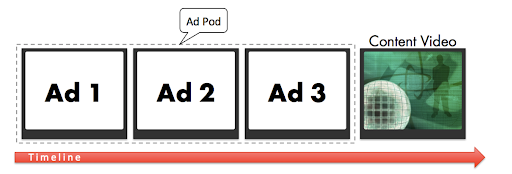

What Are Ad Pods? [Learn the Secret to Maximising Ad Revenue!]
![What Are Ad Pods? [Learn the Secret to Maximising Ad Revenue!]](/user/pages/04.blog/49.what-are-ad-pods/Ad Pods Example.png)
Find out what ad pods are, where they came from, and why they're such an important technology for monetising video content and live streams.
Anyone who’s making money from video content should be thrilled about the widespread adoption of ad pods. This innovative adtech solution gives you the control and flexibility to make more advertising revenue from your VOD, CTV, and live streaming content.
Ad pods emerged on VAST 3.0 back in 2012, as just one of several ad formats supported for video players.
How do they work? If you want to get technical about it, Video Ad Serving Template (VAST) supports the transfer of ad metadata from the ad server to an online video player like Flowplayer.
You can see an ad pod example from IAB’s VAST 3.0 template below:

So, are ad pods right for your business? In this post, we’ll dive into what ad pods are, how they work, and why you probably should be using them to monetise your video content!
What is Podding for Ads?
What are ad pods?
Ad pods are simply a group of ads shown in sequence within an ad break. If you think back to the golden era of television, a show’s linear commercial break included a set of several commercials in a row – and ad pods are basically the same thing, but applied to VOD and live streaming content.
The distinction here is, by grouping ads into ad pods, you’re able to dynamically return more than one ad in a single ad request.
If you can think of “ad pods” as pea pods, but for ads, that should help you remember what they are!
How Do Ad Pods Work?
In terms of the technology behind them, ad pods are inserted into your video either on the client side (CSAI) or the server side (SSAI).
Once this occurs, it halts video playback and triggers an ad break. If there’s a “Skip Ad” option, the viewer may use it to return to their video right away – otherwise, the viewer will watch each ad in the pod back-to-back. Once all ads are finished, the video returns.
It seems pretty straightforward, but behind the scenes, ad pods are doing a lot. Here’s a quick summary:
- They’ll attempt to play each individual ad in a specific sequence based on assigned sequence numbers for each ad.
- If an ad isn’t played for some reason, the ad pod simply assigns that slot to whichever ad is up next in the sequence.
- Pods can be customised with parameters like maximum ad pod length, number of ads, and length of each ad – this can change which ads appear in your ad slots and when.
Ultimately, this information will come in handy when you’re looking to figure out how to maximise your ad revenue!
Using ad analytics found in a video player like Flowplayer, you can actually experiment with these different ad pod settings to find the optimal combination for maximum revenue.
3 Reasons Why You Should Use Ad Pods
As I mentioned earlier, the best use case for podding is long-form VOD content and live streams.
Ad pods are a great way to drive higher fill rates and boost overall monetization – and because these formats tend to offer premium value, you’re usually able to get away with more ads and ad breaks.
There are many benefits to using ad pods in your video content. In this section, we’ll look at three of them!
1) Improve the Viewer Experience
Whenever you serve ads to your viewers, you’re striking a very fine balance between getting more ad watch time and maintaining high viewer retention.
Think about the two absolute extremes: either you have no ads playing and make no ad revenue at all, or you have only ads playing and people have no reason to watch at all. Clearly, we need to find a middle ground here.
The good news is, ad pods can help improve the user experience in a few key ways:
- It prevents the annoyance of seeing duplicate ads within the same ad break
- It can tailor the ads to each viewer's individual preferences
- It can streamline the appearance of ads to allow for more uninterrupted watch time
These are worth thinking about if you want to maximise revenue. In reality, there’s nothing more important than making your viewers stick around and engage with your content – because if they’re not watching, then you have nobody to advertise to!
2) Increase Your Ad Fill Rate
As we discussed in our post on ad fill rate, one way you can make more money on your ads is simply by having more ads served anytime they’re requested. For example, if you have 100 ad requests with 50 ads served, you have a pretty mediocre 50 percent fill rate.
So, how do ad pods help improve that all-important ad fill rate?
Well, pods allow you to fill multiple ad slots from a single ad call – and you can set it up for greater flexibility. For example, say you didn’t have a 30-second ad that you could play in your ad pod, but you could call two 15-second ads instead. Now, all of those ad slots are filled instead of going to waste.
Because ad pods are structured in a sequence, there’s a better chance that each ad call will result in filled ads, and in turn, more advertising revenue.
3) Make Advertisers Happy
As a publisher, ad pods give you a lot more control over the placement of ads – and this actually helps you make advertisers happier. Here’s how.
One concern is competitor separation. Say you have a 1:30 ad break, and you play a 30-second ad for T-Mobile, followed by Sprint, followed by AT&T. As a publisher, you may not mind, because you get paid for all three ads regardless – but none of these advertisers want their message diluted by showing up alongside direct competitors.
Because ad pods allow for greater control and targeting, you can avoid this scenario and give advertisers more value by not running their ads right before or after the competition – and you can also avoid running their ad multiple times in the same ad break (a problem known as “ad duplication”). This has the added benefit of improving the viewer experience and reducing ad fatigue.
Similarly, advertisers have the opportunity to specify which position within an ad pod they prefer – whether that’s the first slot, the last slot, or somewhere in between. This is a privilege they’ll gladly pay up for!
If you use ad pods, you open yourself up to more advertisers who are looking to optimise their ad spend around these ad pod features.
Why You Shouldn’t Use Ad Pods
At this point, I’m sure it’s clear that we’re in favor of the ad pod – and we think you should be too! The ad pod offers a lot of additional control and more opportunities for monetisation.
But in the interest of fairness, I wanted to quickly point out some instances where ad pods might not be as useful.
- Short content. A viewer can get irritated sitting through multiple ads for a short video (say under 5 minutes). If you mostly produce shorter videos and don’t do live streams, ad pods may not be needed.
- Faster ad breaks. You can use ad pods as pre-rolls, mid-rolls, and post-rolls. But if you don’t want to serve your viewers with multiple ads in a row at any of these points, then ad pods may not be the right way to go – to offer faster ad breaks, it may be better to use a single ad (skippable or otherwise).
- No ads. If you have other ways of monetising your content besides ads, and you don’t want any ads displayed on your video content, then ad pods aren’t going to be helpful for you.
Aside from these cases, ad pods are a valuable and versatile option for monetising your videos. If you don’t have ad pods deployed on your videos yet, it’s well worth exploring how they can help your business grow!
How Can You Start Using Ad Pods?
As a publisher, broadcaster, or business, one of the best ways you can get started with ad pods is with Flowplayer, a powerful online video player that comes built-in with full support for ad pods for all enterprise-level customers. All you need is your own ad server, which is where the ad pod is actually created.
What’s more, our enterprise customers enjoy total control over ad placement within their video content on Flowplayer, as well as ad scheduling and in-depth ad analytics. To see how an optimised ad pod would appear within Flowplayer, check out the Flowplayer ad tester here.
If you’re interested in learning more about the other ad analytics and monetisation options found in the enterprise level of Flowplayer, please don’t hesitate to get in touch! We’re happy to give you a live demo or offer a free trial of the software to help you reach your video monetization goals.